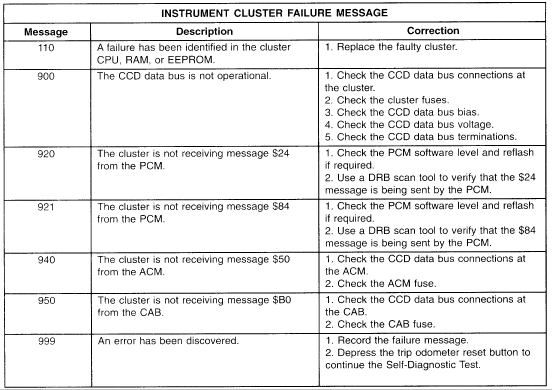
DML FAQ

DML FAQ : Electronics
: How can I recalibrate my instrument cluster?
Q:
How can I recalibrate my instrument cluster?
For a '97-'00, while holding the trip odometer, turn the key to the ON position. The
needles will move to 3 stops. They are:
| Gauge |
First stop |
Second stop |
Third stop |
| Battery |
9.5 (first line) |
16 |
18 |
| Coolant |
140 (first line) |
210 |
260 |
| Tachometer |
1000 |
3000 |
5900 |
| Speedometer |
20 |
55 |
120 |
| Oil pressure |
35 |
55 |
110 |
| Fuel |
1/8 |
1/4 |
Full |
From Bernd, the full procedure for a 1997:
- Begin the test with the ignition switch in the Off position.
- Depress the trip odometer reset button.
- While holding the trip odometer reset button depressed, turn the
ignition switch to the On position, but do not start the engine.
- Keep the trip odometer reset button depressed for about ten seconds, until CHEC appears in the odometer display, then release the odometer reset button.
- A series of three-digit numeric failure messages may appear in the odometer display, depending upon the failure mode. If a failure message appears, see the Instrument Panel, Gauges and Warning Indicators/Instrument Panel/Instrument Cluster Failure Message chart for the description and proper correction. If no failure message appears, the Self-Diagnostics will proceed as described in Step 6.
- The cluster will begin the odometer walking segment test. This test will require the operator to visually inspect each odometer segment as it is displayed to determine a pass or fail condition. First, all of the segments will be illuminated at once; then, each individual segment of the odometer display will be illuminated in sequence. If any segment in the display fails to illuminate, repeat the test to confirm the failure. If the failure is confirmed, replace the faulty instrument cluster. Following the odometer walking segment test, the cluster Self-Diagnostic Test will automatically proceed as described in Step 7.
- The cluster will perform a bulb check of each indicator lamp that the cluster circuitry controls. If an individual amber indicator lamp does not illuminate during this test, the instrument cluster should be removed. However, check that the incandescent lamp bulb is not faulty and that the bulb holder is properly installed on the circuit board before considering instrument cluster replacement.
- If the bulb and bulb holder check OK, replace the faulty cluster. Each of the red indicators are illuminated by a Light Emitting Diode (LED) . If an LED fails to illuminate during this test, the instrument cluster must be replaced. Following the bulb check test, the cluster Self-Diagnostic Test will automatically proceed as described in Step 8.
- The cluster will perform a gauge actuator test. In this test the cluster positions each of the gauge needles at three different calibration points, then returns the gauge needles to their relaxed positions. If an individual gauge does not respond properly or at all during the gauge actuator test, the instrument cluster should be removed. However, check that the gauge terminal pins are properly inserted through the spring-clip terminal pin receptacles on the circuit board before considering instrument cluster replacement. If the gauge terminal connections are OK replace the faulty instrument cluster.
- The Self-Diagnostic Test is now completed. The cluster will automatically exit the self-diagnostic mode and return to normal operation at the completion of the test, if the ignition switch is turned to the Off position during the test, or if a vehicle speed message indicating the vehicle is moving is received from the PCM on the CCD data bus during the test.
Go back to Step 1 to repeat the test, if required.
Instrument cluster codes:

Contributed by: Jeff, Bernd Ratsch
Last updated: Sun Oct 13 10:51:52 2002
![]()
![]()
